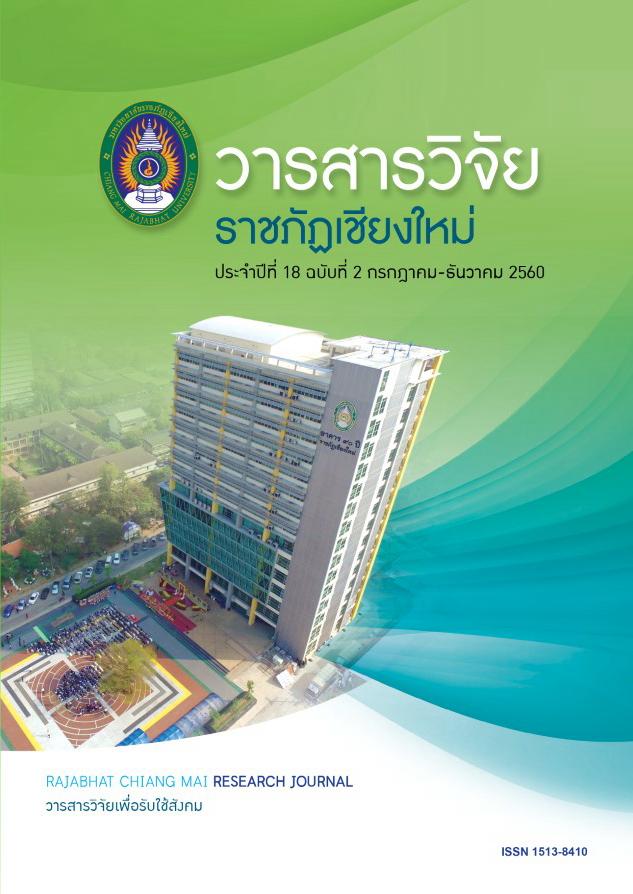Development Model of Elderly Clubs in Chiang Mai Province
DOI:
https://doi.org/10.14456/rcmrj.2017.209652Keywords:
Development model, Elderly club, StrengthenedAbstract
The qualitative research, Development Model of Elderly Clubs in Chiang Mai Province, have purpose to study the development and effects from the development of elderly clubs in Chiang Mai by the application of community based research, action research and participatory rural appraisal. The research, that studied 38 elderly clubs in Chiang Mai, used structural in-depth interviews to collect datas from 456 people consist of chairmans, committees, members and networks since 2559 to 2560. The results of this research are 1) the development of elderly clubs in Chiang Mai, that established within communities, has got supporting like mentoring system from government agencies. Their activities have been essentially exercise and recreation. Also, they have had the planning, processing and easily monitoring. They have brought their collected datas and performance of club activities to conclude and explain to their members periodically. Consequently, they have used technology to explicate and distribute informations and news efficiently. Their development started from families that gather together as a communities and have created networks among the groups into the Digital Society. 2) the effects from the development of elderly clubs in Chiang Mai have led participation of community leaders and members in sharing their opinions, that make everyone to work with willing. The activities of this research, that have initiatives and learning together in the "We can do it by Anong" model, have influence factors as follows: 1) Willing 2) Exploration 3) Cognition 4) Action 5) Notice 6) Decoration 7) Outstanding 8) Interesting 9) Team in technology 10) Again 11) New 12) Opinion 13) Natural and 14) Good will.
Downloads
References
กระทรวงเทคโนโลยีสารสนเทศและการสื่อสาร. สำนักงานสถิติแห่งชาติ. 2557. การสำรวจประชากรผู้สูงอายุประเทศไทย 2557. กรุงเทพฯ: บริษัท เท็กซ์แอนด์เจอร์รัล พับลิเคชั่น จำกัด.
กระทรวงพัฒนาสังคมและความมั่งคงของมนุษย์. สำนักงานส่งเสริมสวัสดิภาพและพิทักษ์เด็ก เยาวชน ผู้ด้อยโอกาส และผู้สูงอายุ. สำนักส่งเสริมและพิทักษ์ผู้สูงอายุ. 2556. พระราชบัญญัติ ผู้สูงอายุ พ.ศ.2546. พิมพ์ครั้งที่ 7. ม.ป.ท.: โรงพิมพ์เทพเพ็ญวานิสย์.
กองทุนประชากรแห่งสหประชาชาติ และองค์การเฮลพ์เอจ อินเตอร์เนชั่นแนล. ม.ป.ป.. สูงวัยในศตวรรษที่ 21 : การเฉลิมฉลองและความท้าทาย บทสรุปสำหรับผู้บริหาร. (เอกสารอัดสำเนา).
เกรียงศักดิ์ ซื่อเลื่อม สมชาย วิริภิรมย์กูล ปราณี สุทธิสุคนธ์ และจํารูญ มีขนอน. (2554). คุณภาพชีวิตที่ดีของผู้สูงอายุไทย. วารสารควบคุมโรค กระทรวงสาธารณสุข, 37(3) (ก.ค.-ก.ย. 54), 222-228.
ธีระวุฒิ อรุณเวช. 2550. แนวทางการพัฒนางานผู้สูงอายุตามยุทธศาสตร์การพัฒนาสังคม 2550 กระทรวงการพัฒนาสังคมและความมั่นคงของมนุษย์. (ระบบออนไลน์). แหล่งข้อมูล: https://www.m-society.go.th/article_attach/8937/11107.doc (17 กรกฎาคม 2560)
บรรลุ ศิริพานิช. 2539. ชมรมผู้สูงอายุ : การศึกษารูปแบบและการดำเนินงานที่เหมาะสม. นนทบุรี: กระทรวงสาธารณสุข.
ปิยฉัตร ทองแพง. 2554. รูปแบบการพัฒนาธุรกิจท่องเที่ยวสำหรับผู้สูงอายุ กรณีศึกษาผู้สูงอายุ
ภาคกลาง. ดุษฎีนิพนธ์การจัดการดุษฎีบัณฑิต สาขาการจัดการธุรกิจ บัณฑิตวิทยาลัย มหาวิทยาลัยราชภัฏสวนดุสิต.
พัชรี ตันติวิภาวิน. 2555. บทบาทภาครัฐในการเสริมสร้างผู้สูงอายุให้เป็นพลังทาง เศรษฐกิจและ
สังคม. ดุษฎีนิพนธ์ปรัชญาดุษฎีบัณฑิต สาขาวิชารัฐประศาสนศาสตร์ มหาวิทยาลัยรังสิต.
รัชดา พรพิไลสวัสดิ์. 2548. การมีส่วนร่วมของสมาชิกชมรมผู้สูงอายุในการส่งเสริมสุขภาพ : ศึกษาเฉพาะกรณีอำเภอพุทธมณฑล จังหวัดนครปฐม. วิทยานิพนธ์ศิลปศาสตรมหาบัณฑิต (รัฐศาสตร์) มหาวิทยาลัยเกษตรศาสตร์.
รัตนะ บัวสนธ์. 2551. ปรัชญาวิจัย. กรุงเทพฯ: สำนักพิมพ์แห่งจุฬาลงกรณ์มหาวิทยาลัย.
รุจิรางค์ แอกทอง.(2549).การปรับตัวของผู้สูงอายุในเขตเทศบาลนครปฐม จังหวัดนครปฐม. วิทยานิพนธ์ศึกษาศาสตรมหาบัณฑิต จิตวิทยาชุมชน บัณฑิตวิทยาลัย มหาวิทยาลัยศิลปากร.
วุฒิชัย สุขวิริยานนท์. (2549). การพัฒนาผลสัมฤทธิ์ทางการเรียนและทักษะกระบวนการทำงานกลุ่มของนักเรียนชั้นมัธยมศึกษาปีที่ 6 ที่ได้รับการเรียนรู้แบบร่วมมือกันรูปแบบ STAD. วิทยานิพนธ์ศึกษาศาสตรมหาบัณฑิต สาขาวิชาคณิตศาสตร์ศึกษา บัณฑิตวิทยาลัย มหาวิทยาลัยขอนแก่น.
ศศิพัฒน์ ยอดเพชร เล็ก สมบัติ ณัฏฐพัชร สโรบล และธนิกานต์ ศักดาพร. 2555. ลักษณะการดำเนินงานและกิจกรรมชมรมผู้สูงอายุ. รายงานวิจัยคณะสังคมสงเคราะห์ศาสตร์ มหาวิทยาลัยธรรมศาสตร์. พิมพ์ครั้งที่ 1. กรุงเทพฯ: JPRINT2.
ศิริรัตน์ ปานอุทัย และลินจง โปธิบาล. 2552. รายงานผลการวิเคราะห์สถานการณ์ผู้สูงอายุใน
จังหวัดเชียงใหม่. โครงการศึกษาสถานการณ์ผู้สูงอายุในประเทศไทย ศูนย์ความเป็นเลิศทางการพยาบาลด้านผู้สูงอายุ คณะพยาบาลศาสตร์ มหาวิทยาลัยเชียงใหม่.
ศิริวรรณ เสรีรัตน์ และคณะ. 2552. การบริหารการตลาดยุคใหม่. กรุงเทพฯ: ธรรมสาร.
สำนักงานปลัดกระทรวงการพัฒนาสังคมและความมั่นคงของมนุษย์. 2557. ประชากรสูงอายุไทย : ปัจจุบันและอนาคต. เอกสารประมวลสถิติด้านสังคม 1/2558 พฤศจิกายน 2557. ม.ป.ท.: ม.ป.พ.
สำนักงานปลัดกระทรวงการพัฒนาสังคมและความมั่นคงของมนุษย์. ศูนย์เทคโนโลยีสารสนเทศและการสื่อสาร. 2557. ประชากรสูงอายุไทย : ปัจจุบันและอนาคต. เอกสารประมวลสถิติด้านสังคม 1/2558. พิมพ์ครั้งที่ 1. ม.ป.ท.: ม.ป.พ.
สำนักงานพัฒนาสังคมและความมั่นคงของมนุษย์จังหวัดเชียงใหม่. 2560. ทะเบียนองค์กร
สาธารณประโยชน์จังหวัดเชียงใหม่. (เอกสารอัดสำเนา).
สุภางค์ จันทวานิช. 2547. วิธีการวิจัยเชิงคุณภาพ. กรุงเทพฯ: สำนักพิมพ์แห่งจุฬาลงกรณ์มหาวิทยาลัย.
Hawkins, Del I., Best, Roger J. and Coney, Kenneth A. 2003. Consumer Behavior : Building Marketing Strategy. 8nd ed. New York: McGraw-hill.
Kossuth, P. M., and Bengtson, V. 1988. Sociological Theories of Aging: Current Perspectives and Future Directions. In Birren, J. E., and Bengtson, V. L., eds., Emergent Theories of Aging. (online). Retrieved from: http://www.medrounds.org/encyclopedia-of-aging/2005/12 /activity-theory.html. (17 November 2016)
Downloads
Published
How to Cite
Issue
Section
License
1. Articles, information, content, images, etc published in the “Community and Social Development Journal” are copyrighted by the Community and Social Development Journal, Chiang Mai Rajabhat University. In order to properly distribute the articles through print and electronic media, the authors still hold the copyright for the published articles under the Creative Commons Attribution (CC BY) license, which allows the re-distribution of the articles in other sources. References must be made to the articles in the journal. The authors are responsible for requesting permission to reproduce copyrighted content from other sources.
2. The content of the articles appearing in the journal is the direct responsibility of the article authors. The editorial board of the journal does not necessarily agree with or share any responsibility.














